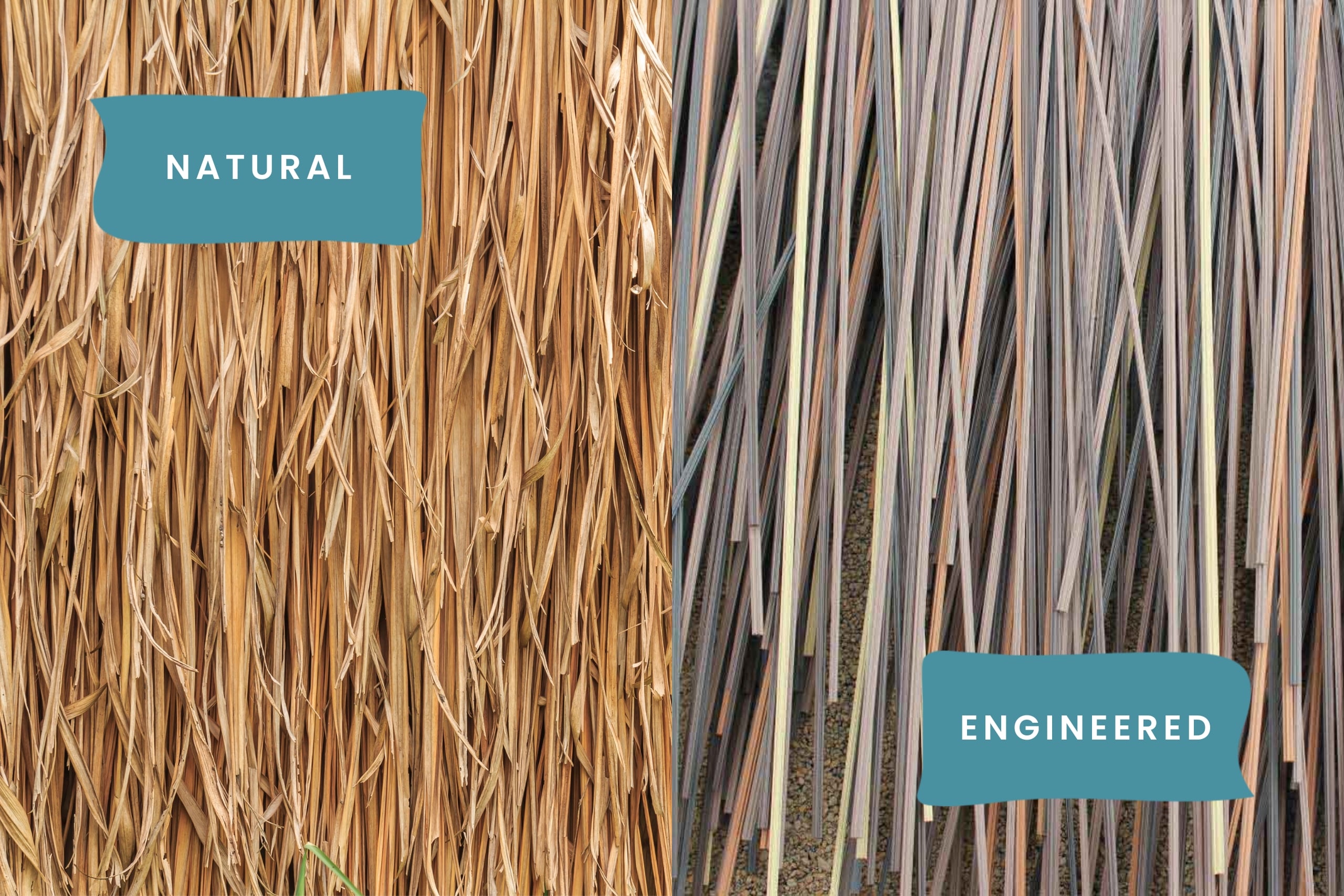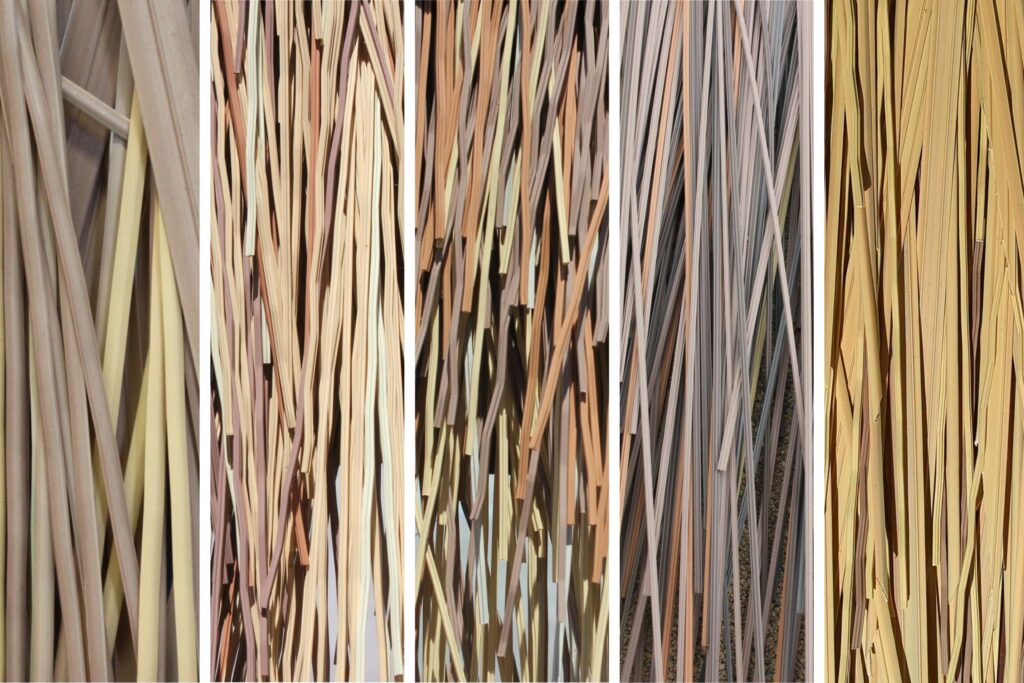
5 Pros and Cons of Natural and Synthetic Thatch Roofing
Thatch roofing stands out in the realm of unique and charming architectural elements. Reminiscent of bygone eras or exotic tropical getaways, thatched roofs bring a distinctive character to any building. However, choosing between natural and synthetic (or engineered) thatch for your roof can be a significant decision.
Endureed specializes in high-quality, long-lasting engineered thatch™ roofing. In this blog post, we aim to help you understand the pros and cons of natural and synthetic thatch roofing, thus enabling you to make an informed choice for your next project. Ready to explore the world of thatch roofing? Let’s jump right in!
Understanding Natural Thatch Roofing
Thatch roofing is a roof covering made from layers of vegetative materials such as straw, water reed, sedge, rushes, or palm fronds. This traditional method of building has been used for thousands of years across the globe, from the English countryside cottages to Polynesian tiki huts, owing to the materials’ natural availability and simplicity of design.
Not merely a relic of the past, thatch roofing is often used today for its enchanting blend of aesthetics and functionality. It offers excellent insulation properties, keeping homes and businesses warm in the winter and cool in the summer—a testament to its green, energy-saving potential. It’s also versatile, shaping easily to different roof structures to create unique and charming silhouettes.
However, natural thatch has its challenges, primarily regarding its demanding upkeep, inherent fire risks, and restricted lifespan. This has prompted the evolution of engineered alternatives, providing the charm of the traditional roof with modern conveniences. In the next section, let’s delve into the benefits and drawbacks of natural thatch roofing.
Pros and Cons of Natural Thatch Roofing

Thatch roofing, while charming and full of character, brings with it a set of benefits and challenges.
Benefits of Natural Thatch Roofing
1. Aesthetic Appeal: Natural thatch roofing has long been admired for its rustic, enchanting appeal. It adds a unique character to buildings, evoking a sense of nostalgia and connection to nature that’s hard to replicate.
2. Renewable Material: Thatch, made from plant materials such as straw or reed, is entirely renewable. Its use has a lower impact on the environment when compared to, say, mining for slate or manufacturing concrete tiles.
Disadvantages of Natural Thatch
1. High Maintenance: Natural thatch requires significant upkeep. It needs regular inspections for damage, rot, or pests. If not properly maintained, repairs can be extensive and expensive.
2. Fire Hazard: Thatch roofs, due to their dry, organic nature, are susceptible to fire. There are methods to help reduce this risk, but it remains an important consideration.
3. Short Lifespan: Natural thatch roofing, depending on the materials and climate, can last anywhere from 2 years in tropical climates to 15 years in moderate climates. This is considerably shorter than other roofing materials, often requiring complete replacement after this time.
As we can see, natural thatch roofing, while beautiful and environmentally friendly in its own right, has some inevitable drawbacks. This is where modern innovation steps in with an alternative – engineered thatch roofing. Let’s explore what it is and what it has to offer.
Introduction to Engineered (Synthetic) Thatch Roofing

In response to the challenges presented by natural thatch roofing, Endureed invented an alternative: engineered thatch roofing. This revolutionary solution offers the look and feel of a traditional thatched roof but with the benefits of modern manufacturing processes and materials. At Endureed, our engineered thatch roofing products are carefully crafted to mimic traditional thatched roofs’ natural charm and texture while overcoming many drawbacks.
Engineered thatch is made from synthetic materials that are shaped, colored, and arranged to replicate the natural variety. This kind of roofing is built to last, offering durability, fire resistance, and low maintenance—features that natural thatch struggles to provide. But how does it compare in detail to its natural counterpart? In the next section, we discuss the pros and cons of engineered thatch roofing, equipping you with the knowledge to make the best decision for your construction or renovation project.
Pros and Cons of Engineered Thatch Roofing from Endureed

Engineered thatch roofing by Endureed offers its own unique set of advantages and considerations.
Benefits of Synthetic Thatch Roofing
1. Long Lifespan: Endureed’s engineered thatch roofs are designed to last 20 years or more in all climates, standing up to various elements and significantly outlasting traditional thatched roofs.
2. Fire & Wind Resistance: One of the hallmark features of our engineered thatch is its fire resistance, a critical safety upgrade over natural thatch. Additionally, our roofs are engineered to withstand the harshest weather, including category-five hurricane winds. This strength can provide peace of mind in volatile weather conditions.
3. Low Maintenance: Unlike natural thatch, our engineered roofing requires minimal maintenance. It’s impervious to rot and pests and does not risk shedding or patchy weathering.
4. Aesthetically Pleasing: Our manufacturing process has been perfected to create products that closely mimic the natural variety, offering the authentic charm and rustic beauty of a natural thatched roof without the associated challenges.
Disadvantages of Synthetic Thatch Roofing
1. Higher Initial Installation Cost: Engineered thatch tends to have a higher initial cost than natural thatch. However, this cost can be effectively negated in the long run when considering longevity and low maintenance needs.
In conclusion, Endureed’s engineered thatch roofing offers a superior, robust, fire-resistant, and weather-resistant alternative to traditional thatch roofing while retaining its aesthetic charm.
The Bottom Line
Choosing the ideal roofing material is an important decision that hinges on many factors, from aesthetic preference to practical considerations. After exploring the key pros and cons of natural and engineered thatch roofing, it becomes evident that each has its unique points of appeal.
Natural thatch offers authenticity, a connection to traditional building methods, and an environmentally friendly material base. However, its short lifespan, high maintenance, and inherent fire risks cannot be overlooked.
On the other hand, Endureed’s engineered thatch provides a resilient, low-maintenance alternative that mimics the charm of natural thatch impressively well. It’s designed to withstand strong winds of up to category-five hurricanes and is fire-resistant – a priceless attribute for the safety-conscious. A slightly higher initial investment offers multiple long-term benefits, making it a viable option for many homeowners and businesses.
Ultimately, whichever path you choose, thatch roofing will lend a remarkable touch of rustic elegance to your building.
Contact the Engineered Thatch Experts at Endureed
Have you been captivated by the charm and practicality of engineered thatch roofing? Are you ready to enhance your property with its allure? At Endureed, we’re committed to providing durable, beautiful, and safe engineered thatch roofing options for all projects. We invite you to explore our variety of robust, low-maintenance products that can transform any building into a picturesque spectacle. For more information, consultation, or to begin your journey with Endureed, contact us today. Embrace the perfect merger of aesthetic appeal and modern convenience that is Endureed engineered thatch roofing.